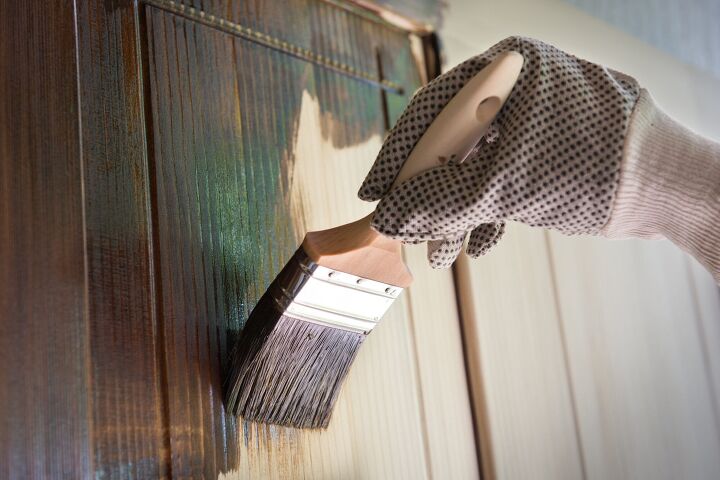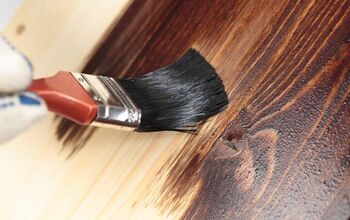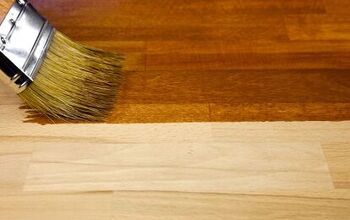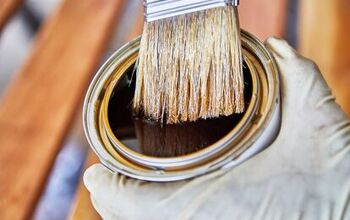Is Wood Stain Toxic After It Dries? (Find Out Now!)

Whether you’re building a toy for your children or constructing a countertop that food is going to be prepared on, you may find yourself wondering about the toxicity of wood stain. More specifically, “is wood stain toxic after it dries?”
Wood stain is considered to be toxic during application and while it’s drying. However, wood stain is no longer toxic after it has cured for 30 days. In regards to food safety, most wood stains cannot be labeled food safe because they are not tested accordingly. Though, they are manufactured to comply with the FDA’s regulations for food safety.
After wood stains have cured, they are generally safe and non-toxic, even if they’re not technically labeled “food safe” by the FDA. Continue reading to learn more about wood stain toxicity, and some more natural options if you desire an alternative that is completely food safe.
Do You Need Painting or Staining Services?
Get free, zero-commitment quotes from pro contractors near you.

Types of Wood Stains and Finishes
There are different types of wood stain used for various applications. Understanding the toxicity of wood stain starts by understanding the differences between the types of wood stains. The type of stain you choose will vary based on use and solvent base.
Wood stains, which may be oil, gel, or water-based, feature dyes and pigments that, when applied, soak into the wood to accent the natural grain.
- Oil-Based Stains: This type is what most think of when it comes to wood stain, as it is widely available and easy to use. Oil-based stains have a slower drying time, which makes them ideal for creating an even finish on furniture or any large wood surface.
- Water-Based Stains: These stains are fast-drying and easier to clean up than oil-based. Since they use water as the binder, they can be easily thinned or cleaned with water. The quick-drying time makes water-based stains ideal for smaller projects.
- Gel-Based Stains: Gel-based stains are a cross between paint and a traditional stain. They can be easily cleaned with mineral spirits and are the best stain for floors or furniture that is made of pine or other woods that are prone to blotching.
- Lacquer: A fast-drying, durable product, lacquer produces an intense, high shine finish. It is typically applied over a wood stain as a finishing coat, protecting the wood and adding luster.
- Varnish: Like lacquer, varnish is typically used as a finish or topcoat over stain. It is a clear, durable solution that yields a glossy finish and forms a protective film.
Oil-Based Wood Stain Toxicity
Oil-based stains with acrylic or urethane binders usually contain harmful chemicals and release high levels of VOCs, or volatile organic compounds. They contain hazardous solvents that bind stain together in order to keep it in liquid form. You’ll often see a number of warnings on the label for oil-based wood stains, including flammable, carcinogenic, mutagenic, and skin irritant.
The main concern is breathing in harmful vapors, but these risks are minimized when the product is used in a well-ventilated space. Ventilation helps reduce the concentration of vapors in the air, which makes the stain safer to work with. With this in mind, wood stain is only toxic during both the application and the drying process.
As the stain dries, the dangerous solvents evaporate and once the stain is fully dry, it’s not considered toxic anymore. Additionally, the flammable nature of wood stain is no longer a concern after the stain is dry and no longer in liquid form. When stain is still wet, it should be kept away from any sources of ignition. This includes the rag used to apply the stain, as it must be left out to dry since it has a chance of spontaneously combusting.
Water-Based Wood Stain Toxicity
When compared to traditional wood stain, water-based stain is substantially less toxic. As such, they usually emit fewer VOCs, dry quickly, and can be cleaned using soap and water. Though, you want to avoid any stains that consist of glycol ether solvents, which can be toxic.
Water-based stains don’t contain the same harmful binders that traditional oil-based wood stains do. While they are still toxic during application, these stains are much less toxic in comparison. For this reason, water-based wood stains are a practical option if you’re looking to diminish your exposure risk during the application process.
Like oil-based wood stains, water-based stains are non-toxic after they have cured. Although they may be slightly more expensive and usually require more coats than their oil-based counterparts, water-based wood stains may be the ideal choice for you to enjoy a safer product overall.
Wood Stain Food Safety
In order for a product to be considered “food safe” by the FDA, it must be tested regularly. Since testing is expensive, stain manufacturers skip this process entirely. For this reason, there are no wood stains available that advertise themselves as being food safe. Though, most wood stains are likely safe for use on woods that will come into contact with food.
For starters, as you are finishing a wood piece, the stain is probably not going to come into contact with any food until after it has dried completely. Additionally, wood stains are engineered to comply with FDA food safety requirements – they just aren’t tested to receive the specific label. This indicates that it’s incredibly likely that, after drying, wood stains can be considered food safe.
However, if you’re still concerned about food safety with your wood stain, continue reading for some alternatives you can consider.
Do You Need Painting or Staining Services?
Get free, zero-commitment quotes from pro contractors near you.

Food-Safe Wood Stain Alternatives
Unfortunately, there simply aren’t any products that are marketed as “food safe wood stain.” Though, if you’re looking for a truly food-safe stain, there are several products that are edible and can serve as an alternative. These include:
Coffee as Wood Stain
Instant coffee that is brewed three to four times the normal strength can make a wonderful wood stain. While it won’t be as dark as many of the stains on the market, it can darken the wood. Before you start, we recommend testing out the coffee stain on a piece of scrap wood. That way, you can ensure that you like the finish.
Oftentimes, the look that coffee stain provides will depend on the type of coffee, strength of the brew, and the type of the wood. Since there are so many variables, it can be difficult to determine exactly what the results will look like – so, make sure you test it first!
Tea as Wood Stain
Tea is another commonly used alternative to wood stain. However, the look is going to be quite a bit lighter than coffee. Overall, it can be hard to achieve a dark color using natural stains. Start by brewing up some strong black tea, and then dip a rag into the brew. Apply the tea stain in the grain to vaguely darken the wood.
Red Wine as Wood Stain
For a non-traditional hue, red wine will give your wood a reddish color. It is easy to apply as a wood stain; simply dip a rag in some red wine and work it into the wood. To achieve a deep color, you’ll probably need to apply no less than three coats of the wine.
Note: With all of the above products, you’ll still need to apply a sealer over top. Without the application of a topcoat, natural wood stains can fade or smear.

Jessica considers herself a home improvement and design enthusiast. She grew up surrounded by constant home improvement projects and owes most of what she knows to helping her dad renovate her childhood home. Being a Los Angeles resident, Jessica spends a lot of her time looking for her next DIY project and sharing her love for home design.
More by Jessica Stone



























